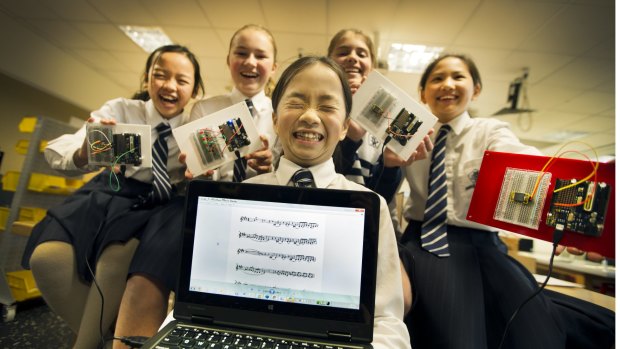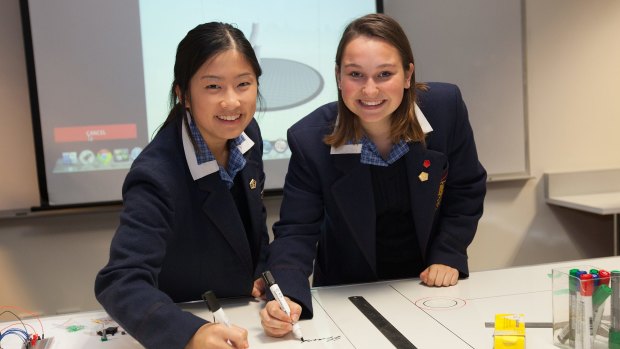By Henrietta Cook and education reporter
3D printers, mini computers and laser cutters are coming to a school near you.
The "maker movement" has hit Victorian schools, with special labs and spaces being set up to excite students about science, technology and maths.

Lauriston Girls School students (from left) Megan, grade 5; Mardi, grade 6; Lauren, grade 5; (front) Isabella, grade 6; Grace, grade 5 learning how to program Arduino boards to generate sounds.Credit: Simon O'Dwyer
The hands-on classes are a far cry from the woodwork lessons you may remember, where wonky birdhouses were hammered together.
Lauriston Girls' School students recently built model houses in their digital fabrication lab, programming the windows to open when the air reached a certain temperature.

Lauriston Girls' students love learning in the digital fabrication lab.
They also programmed solar panels to move across the miniature roofs to chase the sun.
Lauriston is the first school in Australia to create a digital fabrication lab – known as a FabLab – which is a modern science classroom decked out with programming and coding software, 3D printers, hand tools, a laser cutter and computer boards.
Principal Susan Just said the lab encouraged students to become "creative thinkers", giving them important skills for the workforce.
"They go through a process of planning, designing, looking at what has gone wrong, fixing those mistakes and then see what they have created in 3D. That's a really important link in their learning."
The lab – which is part of Stanford University's FabLab@School program – is also useful for subjects like psychology and geography.
Instead of using transparent sheets of paper to create a contour map of the Himalayas, students can simply print a 3D version of the mountain range.
Educators say the maker movement encourages innovation, entrepreneurship, critical thinking and problem solving. It involves creating, tinkering and sharing ideas.
It also engages students in STEM – the educational buzzword that stands for science, technology, engineering and maths.
The federal government is concerned about the declining number of students studying maths and science in their final years of high school and says STEM skills are vital for the jobs of the future.
Charles La Trobe P-12 College is among a growing number of state schools that are setting up "maker spaces" as part of the movement.
At the pop-up space in the school library, students have experimented with mini computer boards donated by Intel that can be coded to drive motors, power lights and respond to sensors.
Leading teacher Nathan Moore said students were teaching other students and teachers about the technology. "It gives them the freedom of being able to engage with their own imagination and direct where they go."
Chief Scientist Professor Ian Chubb applauded the new hands-on approach.
"STEM when it is practiced is awesome. STEM when it is taught out of a textbook can be pretty dry. You have to get the right combination."
He said Australia needed to move beyond the notion that being a service economy that imported everything was "OK".
"We do actually have to make things too. We have to be innovative. We have to look at what the world market needs and feed into those world markets. All of that will take talent and skills and require very clever people doing things differently and a significant proportion will have to be people in the STEM categories."